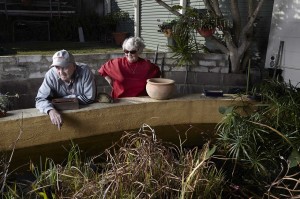Urban ecology in Sydney saves endangered frog
 In Sydney, a Rosebery family’s backyard swimming pool, which helped save a colony of rare frogs, is one of many unusual habitats preserving rare plant and animal species in inner Sydney.
In Sydney, a Rosebery family’s backyard swimming pool, which helped save a colony of rare frogs, is one of many unusual habitats preserving rare plant and animal species in inner Sydney.
Weed-infested railway easements, footpaths and school yards have also become appealing habitats for native plants and animals clinging to their homes as Sydney has developed.
After an extensive urban ecology survey last year, when bandicoots, powerful owls, falcons and red bellied black snakes were spotted in urban areas, the City has released its first-ever blueprint for saving local plant and animal species.
Lord Mayor Clover Moore said the Urban Ecology Strategic Action Plan, which is on public exhibition, set out practical steps people could take to maintain biodiversity in Australia’s most densely populated area.
“Everyone gets a kick out of surprising sightings of powerful owls and falcons around the city,” the Lord Mayor said.
“We need to remember we all have a role to play in protecting and preserving that amazing wildlife, before it’s gone forever.
“There are dozens of ways to create suitable habitats to support our wildlife. Conserving even the smallest green space can help save our local wildlife populations from extinction.
“Being connected with the natural world makes our city a more liveable and enjoyable place to be, and for many people, our parks and open spaces are the only way they encounter plants and animals in their everyday lives.”
Rosebery grandmother Elaine Davies turned wildlife protector when a colony of the fast-disappearing green and golden bell frogs migrated from sand dunes at a nearby industrial site into her disused, above-ground swimming pool.
Ms Davies said she misses them in winter, when their renowned musical call is silent. “I care about them. Some of them will sit and talk to you. In the middle of summer when they are up and out I will always see them and say hello.”
When her children grew up, Ms Davies’ pool was abandoned. “I kept asking my husband to empty the pool and we will get rid of it but he didn’t and the frogs decided they would inhabit it. Without any help from us they just migrated up to our pool. As far as they were concerned it was heaven.”
But young frogs kept getting caught in the pool lining. Mrs Davies turned her pool into a pond about ten years ago and since then it has been home to 30 to 40 frogs each season. Their numbers have declined in the past two years.
The discovery of the endangered frogs delighted ecologists who have fought to protect them at scattered habitats, such as the Sydney Olympic Park brick pits site.
The plan identifies 63 native birds, eight mammals, 11 reptiles and five frog species living in the City of Sydney. Among them, the green and golden bell frog, the powerful owl, the grey-headed flying fox, and the long-nosed bandicoot are threatened species that still call Sydney home.
To fight the pressure of urban development, predators and disease, the City wants to expand bush restoration and ensure that ecology is properly considered in development assessments. It also plans to run workshops about how to create habitats in backyards, balconies, footpaths and schools.
Other wildlife success stories detailed in the plan include restoration work by volunteers on Arthur (Paddy) Grey Reserve in Glebe, which has made the tiny park part of an important wildlife corridor and a new home to the endangered superb fairy-wren.
In Forest Lodge, a terrace house backyard now combines rainforest and undergrowth, attracting reptiles, frogs, rare bees and migrating birds.
The City is already creating habitats for small birds in pocket parks in Glebe and in Blackwattle Bay Park while at Sydney Park in St Peters, wetlands that support birds, frogs and reptiles were incorporated into the stormwater harvesting works.
Target areas for habitat regeneration include:
- Sandstone cliffs at Embarkation Park and McElhone Stairs, Potts Point;
- Bannerman Crescent Reserve, Southern Cross Drive Reserve, and Kimberley Grove Reserve, Rosebery;
- The wetland at Woolwash Park, Zetland;
- Rail corridors where restricted public access adds to their habitat value;
- The University of Sydney, home to one of few known superb fairy-wren populations in Sydney;
- Freshwater ponds at the Chinese Gardens, Darling Harbour, home to the eastern water dragon and eastern water skink; and
- Victoria Barracks, Paddington, where the Defence Department has bush restoration works underway.
A community information session about the strategy will be held on 24 August at the Maiden Theatre at the Royal Botanic Garden.
For more information, contact City of Sydney Senior Media Adviser Catharine Munro. Phone 0467 810 160 or email [email protected]
For interviews with Lord Mayor Clover Moore, contact Matt Levinson 0427 044 768 or [email protected].
loading...
loading...
Tags: frog, green design



Voices of our community